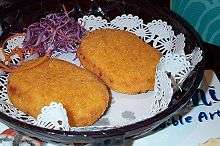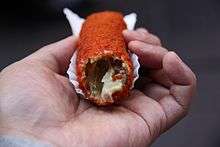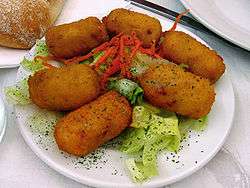Croquette
|
Cylindrical croquettes | |
| Main ingredients | Mashed potatoes, ground meat, shellfish, fish, cheese, vegetables, béchamel or brown sauce |
|---|---|
|
| |
A croquette is a small breadcrumbed fried food roll containing, usually as main ingredients, mashed potatoes or ground meat (veal, beef, chicken, or turkey), shellfish, fish, cheese, vegetables, and mixed with béchamel or brown sauce,[1] and soaked white bread, egg, onion, spices and herbs, wine, milk, beer, or any of the combination thereof, sometimes with a filling, e.g. sautéed onions, mushrooms, or boiled eggs (Scotch eggs). The croquette is usually shaped into a cylinder, disk, or oval shape, and then deep-fried. The croquette (from the French croquer, "to crunch") gained worldwide popularity, both as a delicacy and as a fast food.
Mashed potato-filled croquettes are often served as a side dish in winter holiday meals, such as Christmas. In fast food cuisine, varieties exist without potatoes, but with cheese, beef, or goulash, often in a filling based on béchamel sauce.
Asia



India
A potato-filled croquette called aloo tikki[2] is very popular in northern India and is typically served with a stew. They are mostly eaten as snacks at home and are also popularly sold by road-side vendors. In West Bengal, it is called alu chop, as in Bangladesh. Sometimes it is called a "cutlet" and eaten plain or as a fast food variation that is served inside a hamburger bun (like a vegetarian burger). Meat croquettes called kababs are made with minced mutton. Lightly spiced beef croquettes are a popular snack and appetiser among the Christian communities in Goa and Kerala.[3]
Indonesia
The kroket[4] (Dutch) made of potato and minced chicken inside a crepe-like wrapper is one of the more popular snack items in Indonesia, introduced during the Dutch colonial rule. The kroket is made by wrapping a potato and chicken filling inside a crepe-like wrapper, breaded, and fried.
Japan
A relative of the croquette, known as korokke[5] ( コロッケ ) is a very popular fried food, widely available in supermarkets and butcher shops, as well as from specialty korokke shops. Generally patty-shaped, it is mainly made of potatoes with some other ingredients such as vegetables (e.g. onions and carrots) and maybe less than 5% meat (e.g. pork or beef). It is often served with tonkatsu (とんかつ) sauce. Cylinder-shaped korokke are also served, which more closely resemble the French version, where seafood (prawns or crab meat) or chicken in white sauce (ragout) is cooled down to make it harden before the croquette is breaded and deep-fried. When it is served hot, the inside melts. This version is called "cream korokke" to distinguish it from the potato-based variety. It is often served with no sauce or tomato sauce. Unlike its French cousin, croquettes made mainly of meat are not called korokke in Japan. They are called menchi katsu (メンチカツ), short for minced meat cutlets.
South Korea
Usually called goroke (고로케) or keuroket (크로켓),[6] it is a food sold in most bread shops in Korea. The most common type is deep fried rolls stuffed with japchae (잡채) ingredients or chicken curry and mashed potato with vegetable salad. Also, goroke are sometimes filled with kimchi, pork, and bulgogi ingredients. Many Korean stores often advertise the goroke as a French product and they are usually sold in most European-style bread stores all over Korea.
Europe
Belgium
Almost every restaurant offers kroketten/croquettes as a side dish, and when served this way, they always mean the variety filled with mashed potatoes. As the ubiquitous main dish in Belgian restaurants, croquettes are completely different from the potato filled variety served as a simple side dish. The two most popular traditional Belgian croquettes have a thick and creamy bechamel filling mixed with grey shrimps "garnaalkroketten/croquettes de crevettes or cheese kaaskroketten/croquettes de fromage. Most menus offer both either as a starter or a main course. You’ll find croquettes served almost everywhere in Belgium and the quality comes down to the filling. As a main dish they are usually served with a salad, fried parsley and frites. More adventurous chefs have experimented with the classic formula, adding endives, asparagus, goat’s cheese or beer to their fillings.
France
The ragout-filled dish was regarded as a French cuisine delicacy, first described in a recipe from 1691 by the chef of the French king Louis XIV and using ingredients such as truffles, sweetbreads, and cream cheese.[7] From the 1800s onwards, it became a way to use up leftover stewed meat.
Germany, Austria, and Switzerland
Plain potato croquettes[8] are served as a side dish in restaurants and are also available frozen in supermarkets. They are usually called Kroketten (singular Krokette).
Hungary
Krokett is a small cylindrical croquette similar to the Czech variety: potatoes, eggs, flour, and butter, seasoned with nutmeg and salt and deep-fried in oil. This variety can be ordered in most restaurants as a side dish, and also bought frozen. When made with cottage cheese, they are called túrókrokett.[9]
Italy
In Italy, crocchette (named in the south as crocchè) are made mainly with crushed potatoes or vegetables, like aubergines (crocchette di melanzane). They originate from Naples and Sicily, and are served as antipasti in the pizzerie all around Italy.
Ireland
Plain potato croquettes are available frozen or refrigerated in most supermarkets. They are also homemade, usually with the addition of chopped onion.
Netherlands

After World War II, several suppliers started mass-producing croquettes[10] filled with beef. The croquette subsequently became even more popular as a fast food; meat ragout covered in breadcrumbs which is subsequently deep-fried. Its success as a fast food garnered its reputation as a cheap dish of dubious quality, to such an extent that Dutch tongue in cheek urban myths relate its "allegedly mysterious content" to offal and butchering waste.[11] Research in 2008 showed that 350 million kroketten are eaten in the Netherlands every year. An estimated 75% of all Dutch people eat them, resulting in 29 kroketten per person per year on average. The major consumers are between 35 and 49 years old.[12]
The success of the croquette led to a whole series of food products resembling the croquette, but with other types of fillings, such as noodles, rice and kidney, and with names like bamibal, nasibal, and nierbroodje instead of croquette. Variants of the croquette which specify the kind of meat can also be found, like rundvleeskroket (made with beef) and kalfsvleeskroket (made with veal). Also popular in Dutch snack bars is the satékroket where the filling consists of a peanut satay sauce and shredded meat in a ragout. A smaller round version of the standard beef or veal croquette, the bitterbal,[10] is often served with mustard as a snack in bars and at receptions. Potato croquettes and potato balls (similar to potato croquettes, but small and round) can be bought frozen in most food stores.
Broodje kroket, a croquette on a bread roll, is sold in restaurants, snack shops, and even by street vendors. The popularity of the kroket in the Netherlands is such that even McDonald's sells their version on a bun as "McKroket".[13]
Poland
Croquettes in Poland[14] are basically made from a thin, rolled pancake stuffed with mushrooms, meat, cabbage, sauerkraut, or combinations of those ingredients, then covered in breadcrumbs, fried in a pan, and usually served with a clear soup e.g. "barszcz", similar to borscht.
Portugal
Croquetes[15] are cylindrical, covered in breadcrumbs, and deep-fried. They are usually made with white sauce and beef, sometimes mixed with varying amounts of pork, and frequently with some chouriço, black pepper or piri-piri to add more flavour. Seafood, fish (other than codfish) and vegetarian (potato) croquetes are also eaten in Portugal, but those have other names (such as rissol, pastel, empada), thus the name croquete only refers to the Dutch-style beef croquette.
Russia
The widespread котлета рубленная[16] (from French cotelette) is made of minced meat (beef or pork or mixture of both, chicken, turkey, or fish), bread, eggs, white onions, salt and spices, shaped as a meat patty and pan fried. Bread is added in amount up to 25% of meat, adding softness to the final product and also making it cheaper to produce. Another popular variation similar to French cotelettes de volaille is chicken Kiev, made from boned chicken breast pounded and rolled around cold unsalted butter, then breaded and fried.
Spain
Traditional croquetas[17] in Spain are usually made with béchamel, and only in some cases with mashed potatoes. They are typical tapas dishes, especially filled with jamón, chicken or cod. While in the two latter béchamel is usually employed, potatoes are more common in cod croquettes. Unfilled bechamel croquettes are also consumed in parts of Spain. Also, many bars and restaurants may offer novel, less traditional versions of croquettes with more varied fillings and ingredients such as mushrooms, morcilla (blood sausage), cheeses, cuttlefish (including its ink), etc.
United Kingdom
Croquettes[18] are available frozen[19] or refrigerated in most supermarkets, typically with potato filling.
Caribbean
Puerto Rico
Croquettes are typically made out of ham or chicken[20] and dipped in what is colloquially known as "mayo-ketchup", a variation of fry sauce. Frozen croquettes are sold in supermarkets in Puerto Rico.
Cuba
Cuban croquettes are nearly identical to the Puerto Rican croquettes that are typically made out of ham or chicken, but there is a common cheese and potato variation, and they are sometimes made with fish.
North America
Mexico
Croquettes are usually made of tuna or chicken[21][22] and potatoes. In southern Mexico, a variety is made with fresh cheese, plantain, and black beans.
United States
"Boardwalk" fish cakes and crab cakes, eaten on the east coast of the United States, are essentially croquettes. They consist, respectively, of chopped fish or crab meat, mixed in a buttery dough which is then breaded and deep-fried.
A deviled crab (croqueta de jaiba) is a particular variety of a blue crab croquette from Tampa, Florida. The crab meat is seasoned with a unique Cuban-style enchilada or sofrito sauce (locally known as chilau[23]), breaded with stale Cuban bread crumbs, formed into the approximate shape of a prolate spheroid, and fried. It is meant to be eaten with one hand. It originated in the immigrant community of Ybor City during a cigar workers' strike in the 1920s[24][25][26] and is still very popular in the area.
Other types of crab and fish croquettes are made throughout the southern U.S., especially in coastal states such as Louisiana where seafood dishes are common staples. These varieties have different seasonings and shapes, with some served inside the scooped-out shell of the crab.
A traditional New England/Northeastern United States preparation uses ham, usually of the maple-cured variety, along with cooked mashed potato (often mixed with some mild seasonings and milk or butter for a smoother consistency) for the outer roll. These are dipped in crumbed breading, and sautéed or fried in a small skillet using butter. Typically, these are most common during the Thanksgiving-to-Christmas holiday season as one of several ways to use up leftover holiday ham.
Another croquette dish popular across much of the American South is salmon croquettes. Any canned fish - usually salmon or mackerel, although canned tuna is also used in some recipes (although the dish is often colloquially referred to as "salmon croquettes" or "salmon patties" regardless of the actual fish used) - is mashed by hand to break up any fish bones and give the fish meat a smoother consistency, then combined with a binder and various seasonings. Seasonings typically include pepper, salt, chopped (sometimes sautéed) onions, garlic, lemon juice or paprika. The binder can be any starch such as flour, cornmeal, matzo meal, ground crackers of any type, even white rice or oatmeal - although these latter variations are not as common, and are mostly limited to the northern U.S. Chopped eggs, parsley, and Parmesan cheese may also be added. The mixture is then shaped into rounded patties for pan- or deep-frying; corn or peanut oil are the most commonly used frying oils in the southern U.S., but canola, safflower, or olive oil are also used, and some recipes call specifically for pan-frying in butter or margarine.
South America
Brazil
Croquettes,[27] primarily made from beef, are common in many parts of Brazil. The coxinha is a popular chicken-based croquette, intentionally shaped to look like a chicken thigh.
Ecuador
From Riobamba llapingachos are potato cakes with a cheese filling, fried in oil with achiote and served with a peanut sauce.
See also
References
- ↑ http://www.jamesbeard.org/blog/eat-word-croquettes
- ↑ Stuffed Aloo Tikki Recipe
- ↑ Goan croquettes recipe
- ↑ Indonesia kroket-ragout
- ↑ Hara, Reiko (2006) International Cuisine: Japan ISBN 0-340-90577-8.
- ↑ KBS, Busan (2005)
- ↑ http://www.rnw.nl/nederlands/article/de-kroket-leeft-als-nooit-tevoren
- ↑ German Potato-Croquettes
- ↑ Turokrokett
- 1 2 Dutch "kroketten" and "bitterballen"
- ↑ H. van Dam: Het volkomen krokettenboek, publisher: Nigh & Van Ditmar, 2011
- ↑ http://www.foodlog.nl/artikel/nederland_neemt_een_betere_kroket/
- ↑ http://money.cnn.com/galleries/2008/fortune/0805/gallery.royale.fortune/3.html
- ↑ Polish croquette
- ↑ Portugal Croquetes de Batata
- ↑ russianfoods
- ↑ Spain croquetas-jamon
- ↑ croquette
- ↑ Morrison's own label potato croquettes receive top British Frozen Food Award.
- ↑
- ↑ MexicanCroquettes
- ↑
- ↑ Deviled crab croquettes a tasty Tampa tradition | TBO.com
- ↑ "Bitter Strikes Brought Deviled Crabs" - Cigar City Magazine
- ↑ "A venerable Tampa tradition" - foodmuseum.com
- ↑ "Tampa's Favorite Street Food" - New York Times
- ↑
External links
| Wikimedia Commons has media related to Croquettes. |
| Look up croquette in Wiktionary, the free dictionary. |
- The Official James Beard Foundation Blog, Eat this Word: Croquettes
